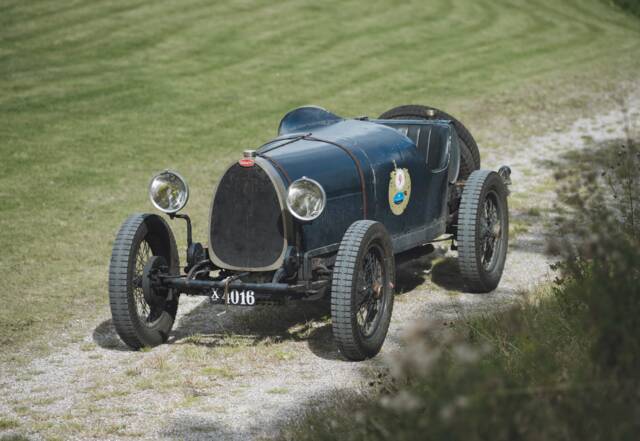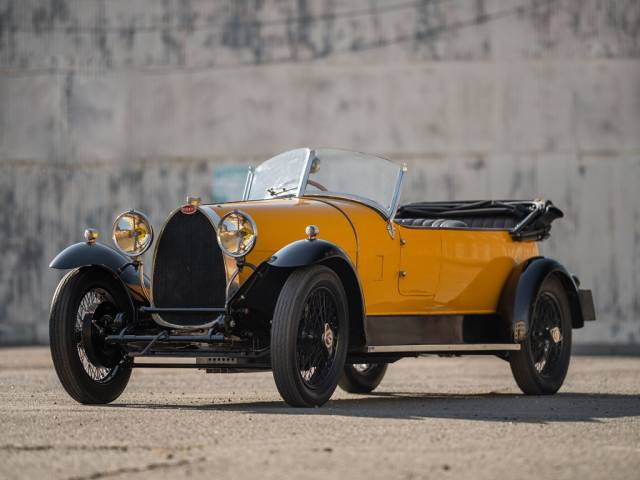Bugatti Type 30 classic cars for sale
The Bugatti Type 30 is regarded as the first true eight-cylinder Bugatti, combining advanced engineering of the 1920s with an elegant open tourer body. Featuring a 2-litre eight-cylinder engine, distinctive coachbuilt bodies, and specific technical innovations, this model stands out among early sports cars. Enthusiasts today appreciate its original build, refined materials, and its pivotal role in Bugatti’s history.
Search results

1923 | Bugatti Type 30
Bugatti Type 30 Grand Prix w. Type 35A engine. Genuine Bugatti Molsheim parts throughout.
Bugatti Type 30 listing references from Classic Trader
Below you will find listings related to your search that are no longer available on Classic Trader. Use this information to gain insight into availability, value trends, and current pricing for a "Bugatti Type 30" to make a more informed purchasing decision.

1926 | Bugatti Type 30
1926 Bugatti Type 30 Tourer
History of the Bugatti Type 30
The Bugatti Type 30, introduced in 1922, marks a turning point for the French manufacturer as the first series-production eight-cylinder vehicle under the Bugatti name. It served as the technical and conceptual forerunner to a range of subsequent Bugatti models, including the Type 38, Type 40, Type 43, Type 44, and Type 49. The Type 30 was notable for breaking new ground in the use of advanced mechanical features for its time—such as four-wheel brakes and a DOHC engine design with four valves per cylinder.
Its launch established a clear Bugatti identity, blending high performance with bespoke coachwork. The chassis often left the factory as a bare rolling platform, then clothed to order by coachbuilders. With more than 500 produced between 1922 and 1926, the Type 30 was a rare achievement for a boutique marque in the interwar years. Visible today are only a handful of surviving examples, most in private hands, highlighting its exclusivity and strong historic reputation.
Model history of the Bugatti Type 30
The Type 30 followed a previous era of mainly four-cylinder models and directly preceded the famous Bugatti Type 35. It set the template for Bugatti's future successes, sharing its core mechanicals with later models and launching the eight-cylinder layout that defined Bugatti through much of the 1920s and '30s. The Type 30’s lineage can be traced through related variants like the Type 38, Type 40, and further developmental offshoots, all using the fundamental engineering introduced here.
Highlights and key features of the Bugatti Type 30
The Type 30 stands out for its innovative use of a straight-eight engine combined with a highly individualised chassis. Original cars were often fitted with unique, sporty open four-seater bodies, featuring details like a pronounced "V" windscreen and distinctive asymmetric door layout. Quality materials—such as brown leather upholstery and rich wooden trim—were standard for the interior. Lighting was typically provided by Marchal headlamps, underscoring the car’s period sporting credentials.
Chassis and engine numbers are preserved in many authentic cars, a hallmark of originality. With an advanced suspension and a configuration engineered for both speed and stability, the Type 30 earned respect among period sports tourers.
Technical data – Bugatti Type 30
Special Editions and Collectible Models
Bugatti built several variations within the Type 30 range, primarily differentiated by coachwork. While all Type 30s are of interest to collectors, cars outfitted for competition or constructed to bespoke customer designs draw special attention. However, all were produced in very limited numbers and individual custom bodies sometimes make one-off cars especially significant.
Engine, Transmission and Handling of the Bugatti Type 30
The Bugatti Type 30’s 2-litre inline-eight utilizes dual overhead camshafts and features four valves per cylinder, a set-up that provided remarkable efficiency and power for its era. Power delivery is smooth and, combined with four-wheel brakes, makes for a confident touring experience by the standards of the 1920s. The car’s chassis, with a unique long-wheelbase and quality suspension, was engineered for both high-speed touring and spirited handling. Open body styles contribute to the visceral drive, while the gearbox and controls, typical for the period, require some adaptation for modern drivers. Noteworthy chassis include tourer-bodies with original frame and axle stamps, brown leather interiors, and period-correct accessories such as the Marchal headlamps—these features are especially prized among aficionados.
Interior, Comfort, Exterior and Design
Type 30 interiors impress with brown leather upholstery and extensive use of quality wood for dashboards and door sills. Exteriors typically feature sweeping bodywork crafted individually by renowned coachbuilders, a sharply inclined V-shaped windscreen, and a distinctive open four-seater format. Some examples have unique asymmetric door arrangements, with left-hand front and right-hand rear entry, adding further intrigue. Accessories included robust fabric convertible tops and period-correct lighting, often with distinctive Marchal headlamps completing the car’s sporting stance. Every surviving Type 30 carries unique bodywork detail, resulting from the highly personalised approach Bugatti offered to its clientele.
Summary – Bugatti Type 30 classic cars for sale
The Bugatti Type 30 is a landmark in early performance motoring: it introduced the eight-cylinder Bugatti engine, set new standards in mechanical sophistication, and offered extraordinary individuality through bespoke coachwork. Its technical innovation, rarity, and historic significance ensure that any surviving Type 30 is an object of serious interest for collectors and those passionate about motoring heritage.
